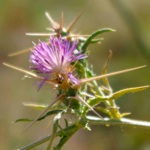Centaurea calcitrapa
Purple star-thistle Γουρουνάκι

Compositae - daisy family Dicot.
Centaurea calcitrapa
Purple star-thistle Γουρουνάκι

Compositae - daisy family Dicot.
A plant which is typical of the Mediterranean biome, Centaurea calcitrapa, forms a wiry bush with narrow spiny leaves and small, thistle flowers surrounded by a star of long sharp thorns. The narrow flowers are formed of purple tipped florets surrounded by spiny bracts (phylliaries). An alternative common name of the plant is caltrop, because of its prickly nature (vide infra).
Surprisingly from the above description the young leaves are edible, just one of many plants which are considered by the Skopelitians as horta (edible wild greens).

Caltrops or tribulae

It is thought that it was first used in the war between Alexander the Great and King Darius of Persia to prevent the advance of approaching foot troops and horses: It was particularly effective against war elephants. Romans used them to inhibit the progress of chariots. It has been used in many conflicts since and with modifications can slow down the progress of modern tanks. Examples of caltrops can be seen in the museum in Alonissos.
The alternative epithets caltrop & tribulus are both used to name spiky plants.




